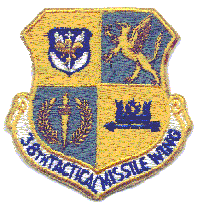|
Sembach Air Base
Hahn Air Base
Bitburg Air Base
Kadena AB
Osan AB
Tainan AB
Lowry AFB
Wheelus AB
Orlando AFB
Camp Happiness
Missile History I
Missile History II
Missile History III
The MM-1
Collectibles
Home Page
|
Missile Support Area - Oberweis

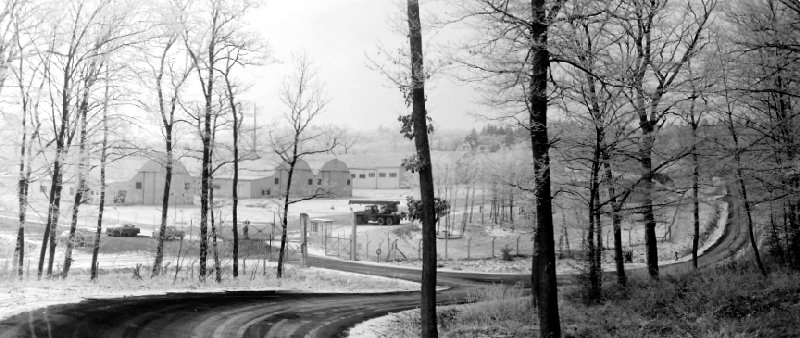
Missile Support Area, (MSA) Oberweis, Germany
(Called Betard by the locals)
December 1963
Hangars from the left: TEMS/MEMS (1), MAST (2 & 3),
E&A (4), GSC&F/C(5)
Maintenance Control (Puzzle Palace) to the right of the
MC-1 Crane.
Photo taken in front of the E&A engine run area by George Mindling (kayakpaddler2010@yahoo.com)

U.S. Air Force Tactical Missiles
By the Editors of this Website!
|
Beyond the Web Page...
The only book devoted exclusively to the Matador and Mace
Tactical Missiles. The book reveals the story from the initial
idea that became the first U.S. pilotless bomber, through the
politically troubled development of the ever evolving
deployment methods of the Matador and Mace Tactical Missiles.
It covers the Units, Groups, Squadrons and Wing that fielded
the missiles. From the United States test sites, Europe, Asia
and North Africa nothing is omitted. All phases of the
application of these two missiles by the U.S. Air Force (and
West German Luftwaffe) are included, from the first tentative
launches of the XSSM-A-1 Matador in January 1949, to the tense
alert duty of the Cuban Missile Crisis, and the final launch
of a MQM13A in May of 1977. The maintenance, logistics and
launch, the men, equipment and tactics are all there.
|
|
"Bob, George, I finished your book 2 days after I received it. Couldn't put it down. It was incredible reading and incredibly detailed information."
Kent Washburn (KWASH55@aol.com) Mace B, Kadena, Okinawa
"George and Bob. I want you both to know how much I enjoyed reading and how much I admire and appreciate what you have accomplished in developing and publishing "The Pioneers". It is truly an outstanding piece of work, reflecting the time and effort required to produce it, but is also a formidable contribution to our military history. I mentioned in some earlier correspondence that I was a little disappointed in the relatively small amount of information regarding the Operating Location/Guidance Sites but you largely made up for it with this magnificent book."
Dale Lake (daleflake@yahoo.com) 601st Tactical Control Squadron, 38th TMW, Hamm, Germany
"I just finished your book, The Pioneers, et al. Please accept my "job well done!" Not only is it informative, but it's very readable. I'd also like to complement you on how well you footnoted it. You have shown that a scholarly work can be both instructive and enjoyable."
Michael Roof (lavinaschnur@hotmail.com) SGM USA (Ret.)
|
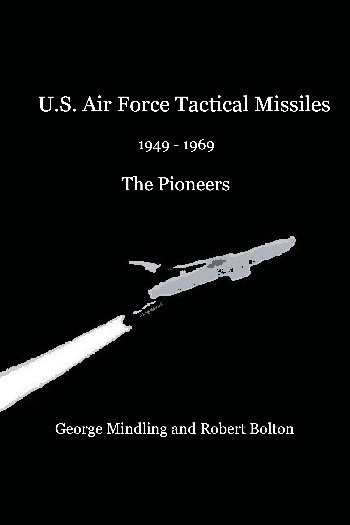
ISBN 978-0-557-00029-6
"Very good work with great detail."
Col. Charlie Simpson, USAF, Retired
Executive Director
Association of Air Force Missileers
"George, the book arrived on Tuesday while I was off to France. Of course, I quickly read the chapter about Germany's quiet step into the realm of nuclear armament. You know, this is still a widely ignored fact over here...
...For me it is fascinating to see what the picture really was in the 1950s and 1960s as opposed to what the official communication of the time wanted people to believe. A fascinating book shedding some light on the early days of tactical nuclear missiles as well as the political background that even today is still largely hidden behind the propaganda of the time. Can't wait to read the rest of it."
Burkhard Domke
Harsefeld, Germany
|
"I have your excellent book on USAF tactical missiles. I actually witnessed the decommissioning of the Maces at Wüscheim back in 1966."
Paul Offen
Talitha, Tye Common Road
Billericay
Essex CM12 9PX
UK
"I just wanted to drop you a line and tell you how much I enjoyed the book that you and Bob wrote. The history was of particluar interest to me and my brother who was a history Professor at the University of Wisconsin. He also thought the book was well written, and he now knows what his little brother, (me), did while in Germany for three years."
George Joseph Snyder (gjsnyder@lanset.com)
71st TMS, Steinborn, Germany
"...by the way, I read your book, it was great, thanks for writing it."
Hack Hunton
(hack@sstelco.com) Mace B, Kadena, Okinawa
|
|
US Air Force Tactical
Missiles © 2008 - George Mindling and Robert Bolton
|
|
Inspired by the 38th TMW Website, George Mindling and Robert Bolton co-authored US Air Force Tactical Missiles 1949 - 1969: The Pioneers ©, the story of America's first
operational missiles, from the Matador to the Mace, from
Taiwan, Korea, and Okinawa to Germany, including Lowry,
Orlando, Holloman, Santa Rosa Island at Eglin, and even Camp
Happiness!
|
|
Dieses Buch ist ein Muss für alle, die im Rahmen ihres Dienstes bei der U.S. Air Force mit den frühen Marschflugkörpern
zu tun hatten, aber auch für deutsche Militärarchäologen, die in der Eifel, im Hunsrück oder im Pfälzer Wald schon
über rätselhafte Hinterlassenschaften gestolpert sind. Nach mehr als 40 Jahren wird endlich eine Fälle von Fakten,
Informationen und Geschichten zu den zwischen 1954 und 1969 in Deutschland stationierten, mit Automwaffen ausgerüsteten
amerikanischen Matador und Mace auf den Tisch gelegt.
Ausfährlich und lebendig erzählen George Mindling und Bob Bolton von den jungen Missilemen, die im März 1954 erstmals in Bitburg ankamen -
noch ganz grün im Gesicht, weil auf dem Atlantik schwerer Sturm geherrscht hatte. Von den T-33-Flugzeugen, die aus übungsgründen so taten, als
wären sie Matador-Flugkörper, äber die Startstellungen hinweg in Richtung deutsch-deutsche Grenze donnerten und sich von der Gegenseite
nur nicht erwischen lassen durften. Oder von der Kuba-Krise, als die US Air Force Europe auf DEFCON 3 ging und an die Mechaniker in
Bitburg Munition für ihre Karabiner ausgegeben wurde.
Augenzeugen sagen dazu: "Wir hätten die Vögel auf jeden Fall innerhalb von 15 Minuten in der Luft
haben müssen!" Es ist lebendige Militärgeschichte, die nun nicht der Vergessenheit anheimfällt, sondern
jedermann zugänglich wird - auch für die ortsansässige Bevökerung, die heute endlich erführt, was sich damals
in ihrer Nachbarschaft zugetragen hat. Den beiden Autoren gebührt der Dank.
Klaus Stark (klaus_stark@t-online.de)
Berlin, Germany
This book is not only a must for all those who served in the U.S. Air Force with the early cruise missiles, but also for German military archeologists who have been puzzling over relics stumbled across in the Eifel, the Hunsrück and the Palatinate Forests. After more than 40 years, we finally have a wealth of facts, information and stories, from 1954 to 1969, of the nuclear equipped American Matador and Mace missiles stationed in Germany placed on the table.
With detailed and vivid descriptions, George Mindling and Bob Bolton talk about the young Missilemen who arrived for the first time in March, 1954, in Bitburg - still green in the face, having prevailed the Atlantic crossing in major storm. Of the T-33 aircraft which practiced as if they Matador missiles launched in the direction of German-German border, or from the Cuban missile crisis, when the U.S. Air Force Europe went on DEFCON 3 and was issued ammunition to the mechanics in Bitburg for their rifles. Eyewitnesses say: "We would have to have the birds in the air in any event within 15 minutes!"
It is vital military history that is prey to oblivion, but is now accessible to everyone - even for the local population, which today finally learns what happened at that time in their neighborhood.
The two authors deserve thanks for saving the history.
Klaus Stark,
klaus_stark@t-online.de
Berlin, Germany
|
|

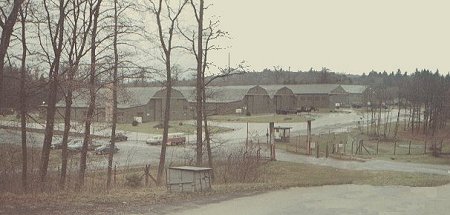
MSA in the spring of 1969.
The entire Bitburg Air Base was painted Olive Drab in the late 1960's to hide it from visual observation.
MSA under construction in 1961 |
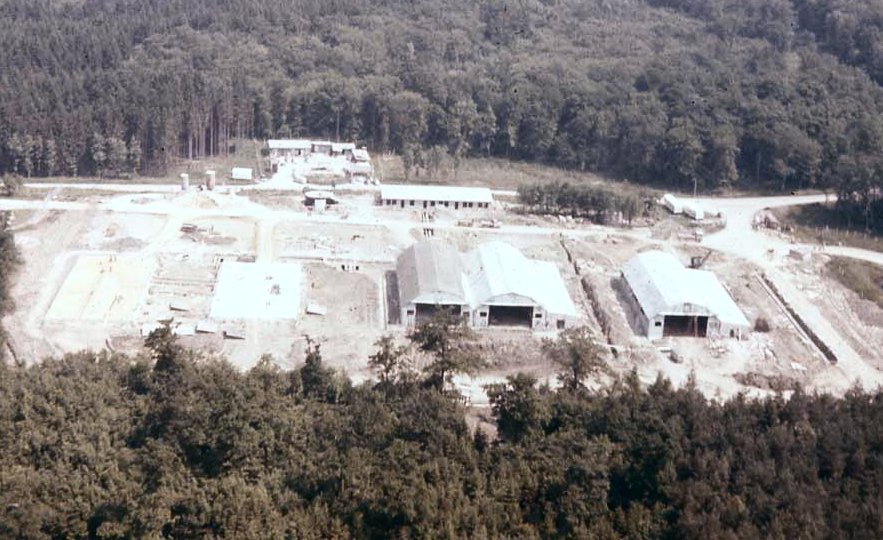
The Photo contributed by
Garld and Janice Edwards (geje@comcast.net), used with
permission |

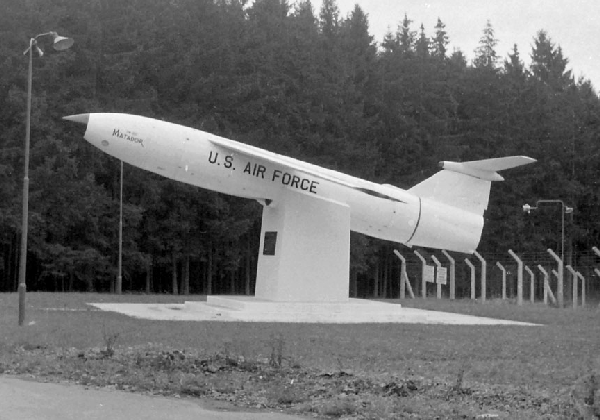
|
|
Dedicated to coincide
with the deactivation of the last operational Matador in
September, 1962, the Matador missile monument had been removed
by the end of the 1980's. The Matador Missile
Monument was re-dedicated in Wüscheim Air Station near Hahn in
1989 at the reactivated, and relocated, headquarters for the
38th Tactical Missile Wing Headquarters.
|
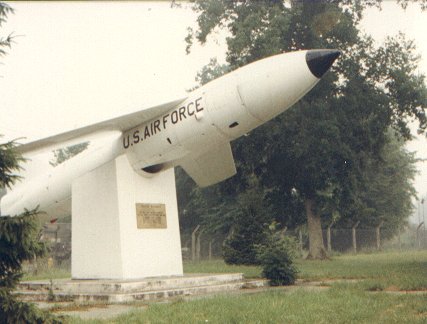 |
|
The TM-61C Matador Missile Monument located in front
of the munitions area, MSA, 1973.
|
|
Photos by and courtesy
of George Mindling (kayakpaddler2010@yahoo.com)
|

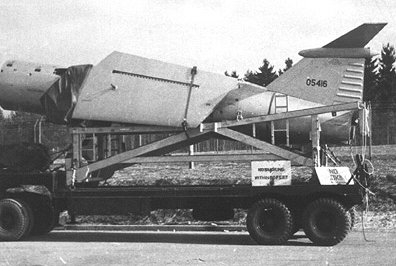
The TM-76B (60-5416) in transport position
Photo courtesy of Glen Curl (gcurl@bv.net)
|
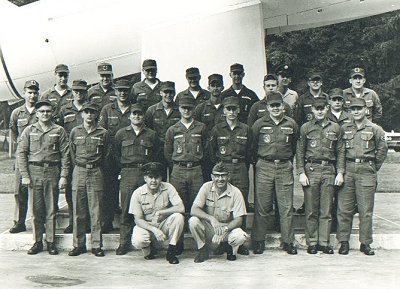
The Entire E&A
Section poses in 1969 in front of the Matador Missile Monument
that was later moved to Wüscheim
|
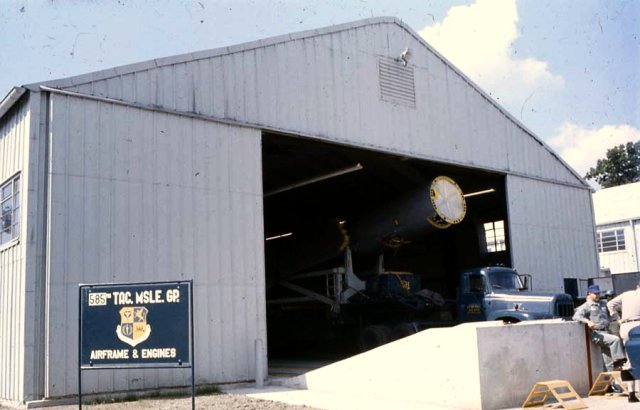
The A&E hangar at
MSA |
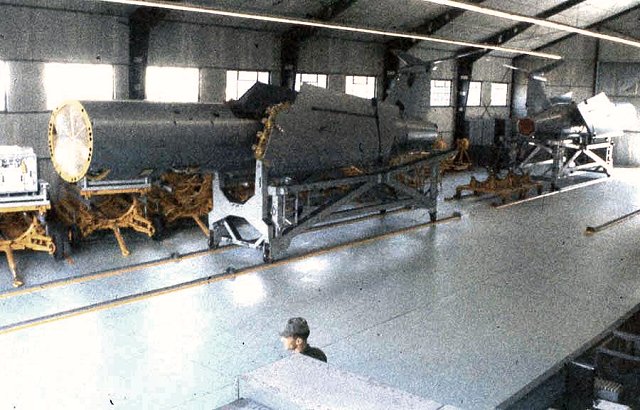
A&E photos
contributed by Garld and Janice Edwards (geje@comcast.net)
|


The Martin Company maintained support facilities at every base
the Matador or Mace was stationed. Their Tech Reps were an integral part of every organization.
Click here to take a look at the Martin Company Depot Maintenance Facility at
MSA. |

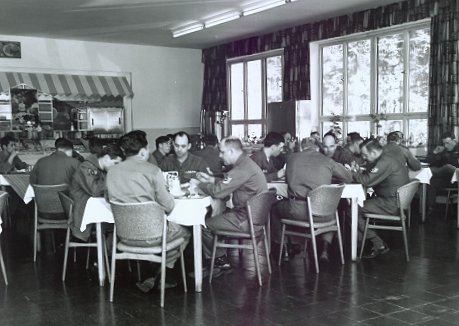
One the best open mess halls in the US Air Force.
Ever had hasenpfeffer? It was served at the MSA Open Mess more than once.
Photo courtesy
of Kathy Geary (k.geary@worldnet.att.net) |
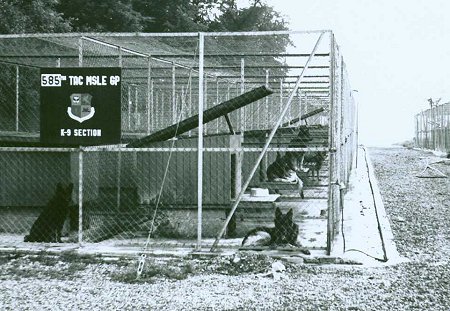
The 585th TMG kennels before the AP unit was merged with the
36th Air Police squadron.
Photo courtesy of Ed
Cole (LMCENC@aol.com)
|

Guidance System Checkout (GSC) and Flight Controls Hangar
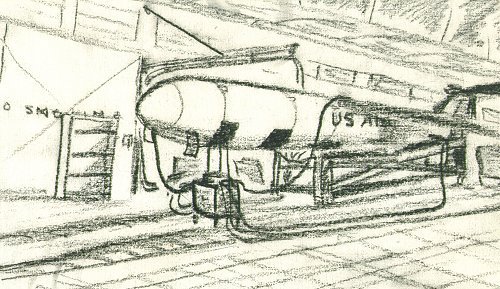
Original art "Checkout" by George Mindling - 1962 © George Mindling
|
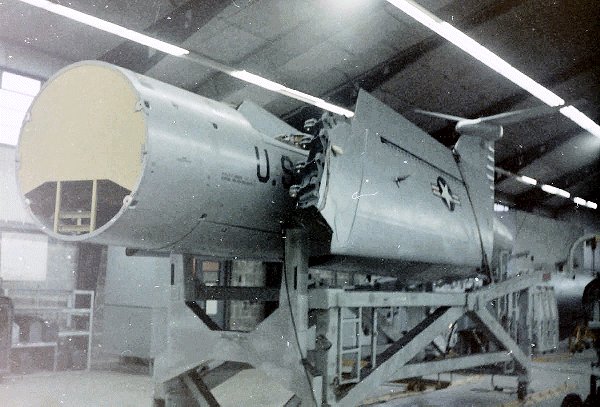
A CGM-13B, still in the checkout/launch but with the wings in the folded
position, awaits being lowered to transport position for the trip to a launch site after
checkout in Flight Controls
The heavy slate
ceiling tiles began to randomly fall after the hangar had been
occupied for less than a year. All personnel had to wear their
"Army" combat helmets in the hangar as there weren't enough
hard hats to go around. Safety tabs had to be welded to each
ceiling cross member.
|
|
The Flight Controls area as seen from the Guidance System Checkout Area. The photo is after the famed "Baby Blue" asphalt floor tiles had been removed from the hangar floor.
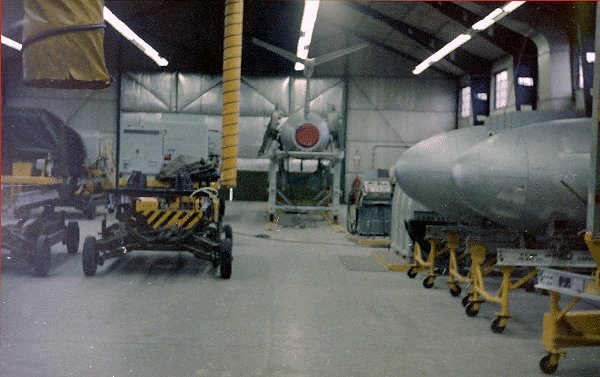
The front of a SCOPS (Systems Checkout Power Supply) sits
behind the last nose section, a Test Set M is visible on the work stand. The trailer to the left is a 4000A with both the "Mod-B" and "Mod-C" used to supply power to the nose section during transit.
The
scorched area above the main door was never
repainted |

"...I was working at the site one nite when we caught the hanger door on fire with a
loaded missile. Myers saved out hide by remembering where the fire extinguisher was, and I
never called him God Hates Myers after that. I was sitting in the office area right next to the door, reading a comic book. Ray was refueling the
heater. The next thing I see is Ray running by me with his ass on fire and he's beating
on his own ass to put the fire out. That's
when the door went up. I guess nobody ever checked to see if that insulation they used
was fireproof or not. It wasn't."
Ted Jarvi (TCJarvi@aol.com)

How NOT to pass an Operational Readiness Inspection... |

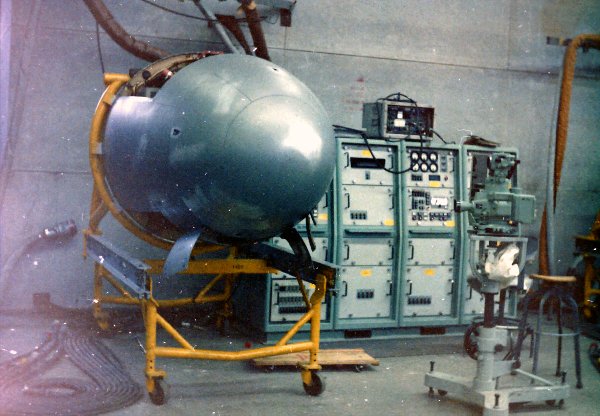
|
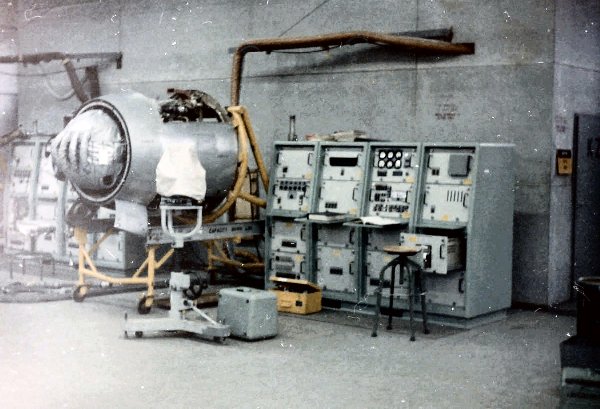
One of the checkout stations in The Guidance System Checkout (GSC)Area
Photos by and courtesy of George Mindling

|
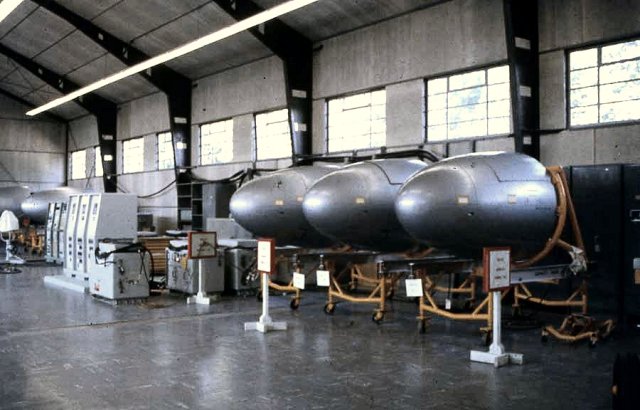
Inspected and tested TM-76 "B" nose sections awaiting dispatch The Photo contributed by
Garld and Janice Edwards (geje@comcast.net), used with
permission
|

This page is in no way sponsored or endorsed by the United States Air Force.
Opinions and views expressed are those of the author and not necessarily those of the
Department of the Air Force.
|
Web Page Design and Development by
George Mindling - Port Charlotte, Florida
© George Mindling - 2003-2006 All Rights Reserved
|
